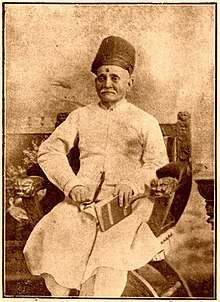Premchand Roychand
| Premchand Roychand | |
|---|---|
 | |
| Born |
March 1831 Surat |
| Died | March 1906 (aged 74–75) |
| Nationality | Indian |
| Occupation | Stockbroker and businessman |
Premchand Roychand was a 19th-century Indian businessman known as the "Cotton King" and "Bullion King" from Bombay.
Life
Born in 1831 he was the son of Roychand Dipchand, a Dasa Oswal Jain, a merchant from Surat. The Roychand family moved to Bombay when Premchand was a young boy. He was educated at Elphinstone College. Recorded as the first Indian broker able to speak, read and write English, he entered the lists as a stock broker in 1849. Apart from the capital markets, Premchand Roychand had significant business interests in the cotton and bullion trades along with the stock market. He was a founding member of The Native Share & Stock Brokers Association which is now Bombay Stock Exchange, the largest stock exchange of India.[1] He earned significant profits from the cotton boom which was triggered by the start of the American Civil War in April 1861 which stayed till 1865.[1][2][3][4]
He lost the majority of his fortune in the Backbay reclamation scheme, and other such ventures.[5] He subsequently earned a portion of it back and turned to philanthropic ventures. The Rajabai Clock Tower in the University of Bombay was named for his mother and was built from a donation of ₹200,000 in 1878.[1][6] He was director of the Bank of Bombay, the largest in the Bombay Presidency.[3] He also invested in other schools, including many for girls such as J.B. Petit High School for Girls; he also established the "Premchand Roychand Award" for outstanding art students with the University of Calcutta. He also donated to the Asiatic Society.[1][7][4]
He died in 1906. His bungalow in Byculla that he named Premodayan became Regina Pacis Convent, an orphanage and school for destitute girls.[8][4]
Further reading
- Sharada Dwivedi (2006). Premchand Roychand (1831-1906): His Life and Times. Eminence Designs. ISBN 978-81-903821-1-3.
References
- 1 2 3 4 Mishra, Ashish K. "Premchand Roychand: Mumbai’s original share king". Livemint. Retrieved 2016-07-27.
- ↑ Kaul, Vivek (2007-03-04). "Mumbai’s first realty bust was in 1865 | Latest News & Updates at Daily News & Analysis". DNA India. Retrieved 2016-07-27.
- 1 2 Lakshmi Subramanian (15 January 2016). Three Merchants of Bombay: Business Pioneers of the Nineteenth Century. Penguin Books Limited. pp. 122–130. ISBN 978-81-8475-721-7.
- 1 2 3 "Premchand Roychand and Bombay dreams". The Hindu Business Line. 2010-02-14. Retrieved 2017-07-18.
- ↑ "An insane interlude in history". www.rediff.com. Retrieved 2017-07-18.
- ↑ Rakesh Kumar Bhatt (1 January 1995). History and Development of Libraries in India. Mittal Publications. pp. 39–40. ISBN 978-81-7099-582-1.
- ↑ Sunavala, Nergish (2016-06-19). "Schools get architects to save a chapter of their own history - Times of India". Times of India. Retrieved 2016-07-27.
- ↑ "This home stood witness to the hands that built Bombay". The Indian Express. 2014-01-21. Retrieved 2017-07-18.